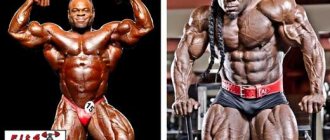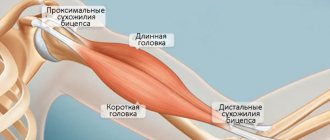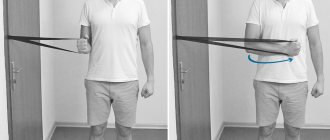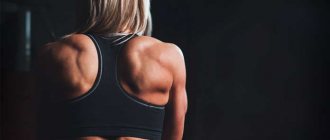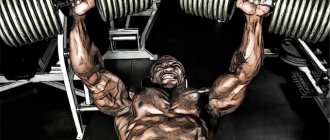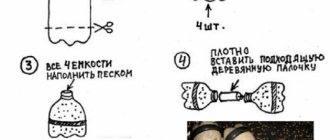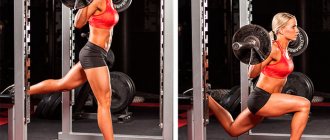Each cell of our body is interconnected with another - this is a well-known fact.
The body is connected not only by blood or by the power of nerve fibers - some organs function better at the same time than separately.
Some muscles in the body work in pairs.
For example, biceps and triceps, chest muscles and triceps.
If you want to quickly pump up your upper body, this article is especially for you.
In it you will learn how to pump up your chest and triceps in a comprehensive workout.
Chest, triceps and shoulders in one day
The logic of this program is based on dividing the body into three muscle groups trained on different days. The training will be staggered - in the first week of the cycle you will need 5 workouts, in the second - 4 workouts per week.
The muscles will be divided into the following segments: the lower body (muscles of the front and back of the thighs, calves), the “pushing” group of muscles of the upper half of the body (chest, shoulders and triceps) and the “pulling” group of muscles of the upper half - the muscles of the back and biceps.
“Pull-Push” training program
- Monday: Push (chest, shoulders, triceps)
- Tuesday: Pull (back, biceps)
- Wednesday: rest
- Thursday: Legs (thighs, calves, abs)
- Friday: rest
- Saturday: Push (chest, shoulders, triceps)
- Sunday: Pull (back, biceps)
Selection of exercises
- The best chest exercises
- Best Shoulder Exercises
- The best triceps exercises
Explanation of the program
FitSeven has already talked about how modern anatomy increasingly views the human body not as a set of bones, ligaments and independent muscle groups, but as a single whole. Any large compound exercise essentially requires the involvement of all muscle groups.
The mass program develops this logic. The training only at first glance divides the muscles into segments - in reality, the whole body works on each training day. Dividing the movements into pulling and pushing, in turn, helps to train the muscles in different ways.
Difference from typical splits
Despite the fact that training large muscle groups twice a week is the easiest way to start muscle growth (splits Mon - chest, Wed - back, Fri - legs are significantly less effective), training too often does not allow the body to recover.
Any large exercise on the chest muscles (for example, a bench press) quite noticeably involves the muscles of the triceps, shoulders and even the abs. If you decide to train your chest one day and your shoulders and triceps the next, you run the risk of overtraining.
Is it possible to alternate days differently?
Working out a muscle group once every six days, recommended in this program, is optimal, but it requires both five training days in one week of training and compliance with a staggered alternation of classes, which is difficult to fit into a schedule.
Unfortunately, these rules are the key factors influencing muscle growth - the frequency of training and its “inconsistency” prevent the body from entering stagnation mode. Reducing training to 3 times a week or switching to a stable schedule will dramatically affect the process.
Selection of exercises
In the first material of the series, we mentioned that the program is designed for fairly experienced trainees who have already achieved a certain result. That is why you must choose specific exercises yourself, based on your needs.
Among other things, only you can say what works more effectively for you - barbell rows, bent-over dumbbell rows or seated horizontal block rows - in fact, these are the same exercise. However, remember to adhere to the specified limit for the number of repetitions.
Number of sets and reps
The optimal number of repetitions when working out one muscle group about twice a week is 30-60 repetitions per workout for large muscle groups (chest, back, legs) and 15-30 repetitions for small ones (shoulders, biceps, triceps, abs, calves) .
Since muscle hypertrophy is achieved with low-repetition training (no more than 5 sets), it is recommended to perform 6-12 sets of large basic exercises and approximately 3-6 sets of “small” exercises for the arms and calves. In total, this gives no more than 4-5 exercises per workout.
Final remarks
The recommended number of repetitions is the number of working repetitions in each workout—low-weight warm-up repetitions are required for compound exercises, but should not be counted. The total duration of the training is no more than 50-60 minutes.
The break between working sets of large exercises should be quite long - about 2-3 minutes. The break between sets of exercises for arms and shoulders may be slightly shorter. However, the final figure depends only on your well-being.
***
The third month of the mass program consists of alternating workouts on the legs, “pushing” and “pulling” muscle groups of the upper half of the body. The total number of repetitions of exercises in the training of each of these groups is no more than 45-90 repetitions.
Shoulder Exercises
How to properly train the shoulder girdle on the same day as the legs? You should start your training with the deltoids; after energy-intensive leg exercises, you are unlikely to find strength.
Remember! The larger the muscles, the more energy the body will spend on their work and restoration. Start the session with smaller, weaker, lagging muscles without wasting energy in advance.
Dumbbell press standing or sitting
To simplify the technique for beginners or when working with heavy weights, dumbbell presses can be performed while sitting on a bench. Standing press technique:
- feet shoulder-width apart, knees slightly bent to eliminate stress on the knee joint;
- We hold dumbbells in our hands, raising them to the starting position to our shoulders, arms at our sides with our elbows down;
- As you exhale, lift dumbbells, straightening your elbows above your head;
- arms and body should remain in the same axis, without leaning forward or backward;
- As you inhale, smoothly lower the dumbbells to your shoulders without throwing them; lower them more slowly than lift them.
- to gain mass, perform 8-12 repetitions, 3-4 sets.
Arnold press
This type of press is best performed while sitting, since it is necessary to fix the body in a stationary position. To do this, you need to rest your back on a bench set at an angle of 90 degrees:
- sitting, take dumbbells in your hands, turning your wrists inward, holding your forearms in front of you, elbows down;
- as you exhale, lift the dumbbells from the sides, turning your hands in the middle of the movement and squeezing the dumbbells above your head at the top point, as with a regular dumbbell press;
- while inhaling, slowly lower the dumbbells in the reverse order, also through the sides, turning the dumbbells “towards you” at the lowest point;
- and also, for the shoulders you need 3-4 sets of 8-12 repetitions.
Barbell row to the chin
Deadlifts are performed standing with a straight bar:
- Place your palms in the center of the bar with an overhand grip so that the thumbs can touch each other at a distance between them. Hands in a “lock” position, thumbs down;
- feet shoulder width apart, knees also slightly bent;
- as you exhale, stretch the bar along the body, lifting it to the chin, with your elbows reaching out to the ceiling. Do not swing or twist the hand, just raise the bar to the level of the collarbones;
- Gently straighten your elbows as you inhale, lowering the barbell down onto your hips.
- required number of approaches 3-4 8-12 times.
Swing dumbbells to the sides
- standing, knees bent, holding dumbbells in our hands, elbows slightly bent, dumbbells close together in front of us;
- with an exhalation, we perform dumbbell swings from the sides, keeping the angle at the elbow motionless, at the top point lifting it just above the shoulders and hands;
- with a slow movement through the sides, we lower the dumbbells while inhaling, connecting at the lowest point;
- here it is also important not to help with your body and not to perform jerky swings, feel the work of the middle deltas;
- perform swings 3-4x8-12 times.
Bench press
This technique can be performed with a narrow grip, thus the front deltoid will work:
- standing or sitting on a bench, take the barbell with a shoulder-width grip from above, bend your elbows, lift the barbell, and place it on your back;
- As you exhale, push the barbell overhead, bringing your elbows and forearms parallel in front of you. Straighten your elbows at the top point;
- as you inhale, lower the barbell onto your back without touching or throwing the barbell;
- perform 3-4x8-12 reps.
Bent over dumbbell swings
This exercise is designed to work on the rear deltoids. Can be performed either standing or sitting in an inclined position:
- feet the width of the pelvis, knees bent, bend forward with a straight back until parallel to the floor and fix the position, you can rest your head on the bench;
- arms freely lowered, holding dumbbells with elbows slightly bent;
- as you exhale, perform swings through the sides up to the shoulder joints, without straightening your elbows;
- while inhaling, return the dumbbells down, keeping your back straight;
- and also 3-4x8-12.
Training frequency
Any muscles should not be loaded too often - they will not have time to recover from the previous workout. This pattern is determined by the biochemistry and physiology of all living things: muscle fibers are destroyed during active work, and then they are built up with a reserve, “ensuring themselves” in case of more severe tests for the body.
Therefore, the optimal frequency of strength training is 2-3 times a week with breaks of at least a day. Classes should last no longer than an hour. For muscle growth you also need to eat well and properly, consume at least 100-125 grams of animal protein per day
It is equally important to add vitamin and mineral supplements and protein shakes to your diet. Athletes need to drink at least 2.5-3 liters of clean water per day
In this video you will learn how to train your chest and triceps at the same time.
How to pump up your chest and triceps: comprehensive training
Each cell of our body is interconnected with another - this is a well-known fact. The body is connected not only by blood or by the power of nerve fibers - some organs function better at the same time than separately. Some muscles in the body work in pairs. For example, biceps and triceps, chest muscles and triceps. If you want to quickly pump up your upper body, this article is especially for you. In it you will learn how to pump up your chest and triceps in a comprehensive workout.
Training program for chest and biceps muscles No. 2
We offer you another training - a training program for the chest and biceps muscles. This is the second part of the training, and we presented the first earlier. At the end of the article, we will tell you how to avoid injuries during training.
All girls dream of being carried in their arms, and strong arms with large biceps will help the stronger sex with this. When you look at a guy with powerful arms, you can immediately understand that he is taking care of his body, working on it. The sculpted male chest is also no less attractive. It is these muscle groups that this training is dedicated to.
Training program for chest and biceps muscles No. 2: goals and objectives
The presented workout involves visiting the gym three times a week. Rest days should be included between workouts. The total time allotted for mastering the program is 4-6 weeks.
The first day of classes will be devoted to the back and biceps, on the second day you should pay attention to the legs and shoulders, the third day - chest, biceps, triceps. It’s clear from the training plan that we haven’t forgotten the rest of the muscle groups either.
Leg muscle training is done to maintain tone once a week. Don't forget about your abdominal muscles and spend time on them in every workout.
The program will include supersets, so get ready for some serious work.
Don’t forget to take care of your joints; to do this, we recommend not to fully bend or straighten them under load.
Warm up as usual before your main workout.
Is it better to start pumping your arms with biceps or triceps?
In programs on how to pump up triceps and biceps in one day, there is no single system and algorithm of action. But most are still inclined to work out the triceps training program first, and leave the biceps training for a snack.
At the same time, in supersets, on the contrary, it is recommended to combine exercises with each other: biceps training, triceps exercises, and again biceps.
Try different approaches and find the one that works for you. Remember that during the training process you must thoroughly work both muscle groups.
Specialization programs: pumping up the chest, biceps and abs
The chest, biceps and abs are called the “front” of the body. The appearance of the athlete largely depends on how effectively they are pumped. How are you doing with those muscles? Isn't that great? Specialized training is ideal for them.
So, for those who do not know the terms, I will explain: specialization is shock training of one muscle group with the goal of its maximum development and pumping. To the detriment of other muscles? Exactly! To the detriment of others. You train all other muscles at half strength. This program is used to eliminate “gaps” in the muscles. For example, you have pumped up your chest well, but at the same time, the under-pumping of your arms against the background of your beautiful breasts has become even more noticeable. In this sense, the goal of specialization is to target the biceps and triceps. As for our program today, it will allow you to quickly pump up the most spectacular muscles - chest, biceps and abs, thereby radically transforming your image as a bodybuilder. Even if you are okay with this, you can still try it just for fun, purely for yourself. After all, you can never have too many biceps, chest and abs.
Principles of specialized training
All specialization programs have common principles that determine the intensity of training, the frequency and nature of the loads, as well as methods of concentration.
Training frequency.
All specialization programs involve 2 workouts per week on a specific target muscle. In the “Arnold era,” they trained like this: two days they did highly specialized training, and the third day was devoted to the overall pumping of other muscle groups. Moreover, this third day was rather weak in intensity. Situated between two specialized days, the third became a kind of respite before the second training day. Today a completely different approach is being taken. You train the target muscle twice a week, and spread the programs for the remaining muscles over two days. Due to this, you can significantly increase the intensity of the load without losing volume and strength. Moreover, without damage to the main pumped muscle.
One of the specialized workouts will be the main one, the second - auxiliary.
Volume and nature of loads
Even the strongest bodybuilder is unlikely to be able to withstand a specialization program for a period of 2-2.5 months, so much shorter periods are recommended for everyone else - from 3 to 6 weeks. The short-term nature of the program will allow you to use an extreme training intensity regime. Supersets and low-repetition heavy approaches are encouraged here. The training should be as varied as possible. This means using exercises for different bundles of the target muscle, frequently changing equipment and the exercises themselves. The number of repetitions is considered optimal in the range of 8-12 times.
The main condition for the success of a specialized program is the ability to feel the work of the target muscle. If this is still unfamiliar to you, then you need to forget about this program for a while.
When specializing, extreme composure is required, so the target main muscle is always loaded first. Before the main training, you need to have a good rest and restore not only physical, but also moral strength. Lack of sleep and nervous stress are not allowed.
So, let's finally move on to the program itself.
Monster chest
You should start with basic specialized chest training. Preferably at the very beginning of the week, since during the weekend your strength has sufficiently recovered. Next comes a back and biceps workout. Obviously, it’s not worth putting too much effort here, since our accent is completely different.
The chest program consists of 4 exercises with 15 sets of low, medium and high repetitions. When you have to do chest, deltoids and triceps exercises at the same time (day 5 of training), start the program with 1-2 basic exercises (horizontal press and/or bent-over press) and 1 isolation exercise (for example, butterfly) in the simulator or dumbbell fly). Perform 3-4 sets of 8-12 repetitions in each exercise, and then proceed directly to training deltoids and triceps.
Specialized chest split
How to pump up your pectoral muscles
Work on the pectoral muscles.
Experts do not recommend doing more than two chest workouts per week. For beginner athletes, it is enough to perform 2 exercises of 2-3 approaches each. For more advanced athletes, it is optimal to do 6-8 repetitions to increase strength, and 10-12 to build muscle mass.
Advice! Almost all exercises for chest training include the work of the triceps, so when creating a training program. Exercises for the pectoral muscles and triceps should be done on different days.
Let's look at some basic exercises to build up the pectoral muscles:
- Bench press. It is considered the best exercise for beginner athletes. The main advantage is the ability to pump different areas of the chest by changing the inclination of the bench (positive tilt - pumps the upper chest, tilting your head down - pumps the lower area). The number of approaches depends on the training program and on average is 3-4 approaches. You need to do 6-12 repetitions.
Execution technique. Take your starting position on the bench: you need to lie down, pressing your buttocks, shoulders and head to the surface, place your feet on the floor, placing them shoulder-width apart. Take the barbell with a wide grip and lift it up above the center of your chest.
Advice! Be sure to enlist the support of your partner to insure you at first.
How to pump up your breasts correctly? This question is asked by almost every person who wants to have a beautiful body. But since even among professional athletes the pectoral muscles often lag behind in development compared to the general muscles, this issue requires a thorough approach.
As you inhale, lower the barbell down until it lightly touches your chest, hold your breath. As you exhale, lift the barbell up and hold it in this position, straining your pectoral muscles as much as possible. The barbell should be lowered slowly and raised at a moderate or fast pace.
Performing a bench press.
- Dips. When performing this exercise, most of the muscles of the body are involved in the work: chest-biceps, muscles of the back and shoulder girdle, arms and abdominal muscles of the press.
Execution technique: Take the starting position on the uneven bars with your arms outstretched. This position contracts the muscles and prepares them for stress. You need to tilt your torso forward and slowly lower yourself down while inhaling. After a pause, straightening your arms, as you exhale, slowly rise up. To avoid creating the risk of injury to the elbow joint or pectoral muscle, chest-biceps training should be done slowly.
Important! Watch the position of your elbows: they should be spread out to the sides. Keep them away from your ribs while lifting
This will increase the effect of the exercise.
Performing push-ups on parallel bars.
When performing this exercise in the gym, you should adjust the number of approaches depending on the program. On average, perform 2-3 approaches 6-10 times. Keep in mind that you can only engage the pectoral muscles by going deeply down when performing the exercise. Otherwise, the chest muscles will be used only partially, the triceps will work mainly.
Beautiful breasts are the dream of every lady. To maintain it in good shape requires persistent and systematic training. Let's figure out how to pump up a girl's breasts at home.
How to stretch your triceps
Every workout should begin with thorough mobility training that prepares your joints, tissues, and nervous system for the type of training you'll be doing. Rusin likes to start any chest training session with an exercise that warms up the shoulders and upper back. From there, you'll train the chest with low and high reps to target the widest range of muscles and finish with a grueling triceps kick.
High Angle Face Pull
Sets: 4, reps: 15, rest: 60 sec.
Step 1: Install a cable pulley at head height or tie a resistance band to a power rack at the same height. If using a cable, attach the cable handle to the pulley.
Step 2: Stand up straight and, holding the rope or band with both hands, reach towards your face. Pause for a second in the fully contracted position and then return to the starting position.
Dumbbell Bench Press
Sets: 3, reps: 5-8, rest: 60 sec.
Step 1: Lie down on a flat bench holding a pair of dumbbells on your shoulders. Your palms can face your feet or your sides if that's better for your shoulders.
Step 2: Press until your elbows are fully extended, squeezing your pecs as you lift. Make sure that as you lower the weight to the bottom position, you feel a stretch in your pectoral muscles below.
Weighted push-ups
Sets: 3-4, reps: 10-15, rest: 30-45 sec.
Step 1: Get into a push-up position with your hands shoulder-width apart and your legs straight behind your back, hip-width apart. Tuck your pelvis slightly so that it is perpendicular to the floor, and tighten your buttocks and abs. Have a partner place a weight plate, chain, or sandbag on your back for added resistance.
Step 2: Lower your body to the floor, keeping your elbows close to your sides as you descend.
Step 3. When your chest is an inch above the floor, move back, spreading your shoulder blades out to the sides.
Kneeling rope press
Sets: 3-4, reps: 15-30, rest: 20-30 sec.
Step 1: Attach a rope handle to the cable station pulley. Grab the ends of the rope and kneel facing the station.
Step 2: Keeping your elbows close to your sides, extend your elbows and open your fists out to the sides at the bottom of the rep as you squeeze your triceps hard. Hold for a moment and then lower the weight. Allow your elbows to move forward slightly at the top of the movement to stretch your triceps.
Main principles of combination
Each person is individual, therefore, for some, 1-3 workouts per week is enough, and for some, 5 sessions are not enough. There must be moderation in everything. After grueling workouts, muscle fibers and bone tissues must fully rest and recover, otherwise you should not expect obvious progress.
It is recommended to include abdominal training at the end of each workout, so exercises for abdominal training will not be noted below in the diagrams. To achieve the desired results, you need to take note of the correct sequence of exercises:
- shoulders;
- pectoral muscles;
- trapezium and neck;
- back extensors;
- biceps;
- triceps;
- legs (in this case we are talking about the buttocks).
The main rules for combining training
Basic rules of combination developed by professional athletes:
- During one workout, you can work out the biceps and triceps muscle tissue along with the triceps.
- Abdominal exercises can be combined with all groups, so it is recommended to leave it “for a snack” at the end of each workout.
- Technical training of the pectoral muscles and triceps in one day will allow you to quickly see good results. It is also recommended to combine training of biceps and deltoids with triceps.
- It is not recommended to pump your shoulders together with the pectoral groups, since during training the deltoids will be very tired, especially the front ones. This combination must be excluded in the training process: the tissues will be overstrained and their growth will not be observed.
- A day of biceps and back training can be combined with forearm training. They are rarely indicated in the diagrams, since according to statistics, no more than 5% of all gym visitors use them.
- If you combine training of triceps and biceps with any other group, they must be moved to the very end of the training process, since hammering your arms will not allow you to effectively work out all the other muscle fibers, for example, the chest or back. The only exception is that the entire workout is devoted exclusively to the arms.
What is the best way to train your arms: together with your shoulders or separately?
Having visited the gym for the first time, beginners turn to trainers, eager to get the perfect individual training plan. Well, this is exactly what was stated at the reception, because basic programs are available at every step on the Internet. As a result, beginners receive the same basic program and absorb the first “myths”. For example, training triceps and biceps on the same day is not effective, and it is better to distribute it into different split patterns. The first day the biceps are pumped with the back, and the other day the triceps are pumped with the chest.
It would seem that if a professional claims so, then this is the truth from the first instance, proven by years of training. Yes, undoubtedly, this program is good for a beginner who is just getting into the taste of training and “warms up” the body, so to speak. But if the goal is to work out your triceps and biceps as efficiently as possible, do like Arnold Schwarzenegger, set aside a separate day for training and pump your triceps and biceps on the same day, separately from your back and chest.
So it turns out that fitness trainers are deceiving naive beginners? Not at all! It’s just that the program for a beginner and someone training “for results” is completely different. Just like the difference between training programs for men and women.
Biceps workout
A workout for a beginner includes a back workout (large muscles) and a biceps workout (small muscles), on another day the chest (large muscles) and triceps (small muscles) are worked out. During this period, the load is distributed evenly, preparing the muscles for heavy loads.
When there is a goal to work out all muscle groups thoroughly and for maximum results, it makes sense to listen to the guru in this matter - the magnificent Arnold Schwarzenegger. It was he who was remembered by the masses as the standard of relief and the luxurious owner of proportional muscles of the chest, shoulders, back and arms.
And he tirelessly repeats that for excellent results it is necessary to pump triceps and biceps on the same day, separately from the chest and back. And that's why! If you work a small muscle at the beginning of a workout, then less energy remains for the large one. The result is worse. If, however, you work out the large muscles and then move on to the small ones (as the trainers advise), then there is little strength left and the small muscles are worked out for general tone, but not for a great result.
Therefore, Arnold developed his own training system: legs + back, legs + chest, legs + biceps + triceps. Regular alternation of programs allowed us to achieve enormous heights.
Workout #3. Insane intensity
Another method of developing the pectoral muscles is to use the rest-pause method. During this workout, we will use this method in different variations at different tempos, and in the last exercise, we will hold the iron in our hands for 8 sets, doing 80 to 120 repetitions.
| 1. Incline dumbbell press with a parallel grip, 4 sets using the “rest pause” technique. 10-12 reps | |
| 2. Seated bench press at different tempos. 4 sets, 16 reps (8 slow, 8 fast) | |
| 3. Superset Incline Dumbbell Flyes 4 sets of 10-12 reps Dumbbell press 4 sets 10-15 reps |
Parallel grip incline dumbbell press – Rest-pause
The rest-pause method is an incredible technique that allows you to perform more reps with heavier weights. After you've warmed up, pick up a weight you can do 6 reps with, do those 6 reps, then rest for 12 seconds. Then do 3-4 repetitions again. Rest again for 12 seconds. Do a couple more final reps until failure. Complete the approach. Notice that during this set you performed twice as many reps as usual!
Seated Press - Various Tempos
Take a seat in the machine to simulate a bench press. Set a weight that you can perform about 12 reps with. Perform 8 repetitions at a very slow pace. 2 seconds rise, pause at the top for peak contraction of the pectoral muscles, 4 seconds lowering the weight. Then perform 8 more repetitions in a fast, continuous manner without any pauses at the extreme points of the amplitude. If you can't complete 8 reps in the fast phase of the set, simply lower the weight.
Supreset: Incline dumbbell flyes, dumbbell press
Supersets are very effective, in which you use the same equipment for both exercises. Perform dumbbell flyes on the bench 10-12 times, and then perform bench presses with the same dumbbells. It's possible that your pecs will be very fatigued by this time and you won't be able to do more reps.
As with all other arm raise movements, don't skimp on the weight. The pectoral muscles must be well worked before you begin pressing exercises. Maintain high intensity throughout your workout.
Leg exercises
Do leg exercises after you've done your shoulders. Start with complex basic exercises with free weights or on a machine, then move on to isolation exercises, which work one muscle.
Squats with a barbell on your shoulders
In order to train with a barbell on your shoulders, not only your legs, but also your abs and back must be strong.
Attention! Improper execution of the technique is dangerous to health! Do not place the bar on the cervical spine. Under no circumstances should you round your back or bring your knees beyond your toes; they should not be sharp; take care of your joints.
The exercise is performed in a power rack:
- place the barbell in the power rack just below your shoulders, bend your knees slightly, squat under the barbell and place the barbell on the top of your trapezius, holding the barbell with a wide grip;
- pushing off with your feet, remove the bar from the racks and take a couple of steps back;
- take a stable position - feet slightly wider than shoulders, pointing your toes slightly to the sides, gaze directed forward and upward to avoid a strong tilt of the body;
- Tighten your abdominal and back muscles, bringing your shoulder blades together, and as you inhale, slowly lower yourself down, bending your knees at a right angle. Shift your body weight onto your heels without twisting your pelvis, pulling your tailbone back, forming a slight arch in your lower back. Squat until your thighs are parallel to the floor, without leaning your body onto your legs;
- as you exhale, perform a faster rise, pushing off with your heels, using the strength of your buttocks and hips to straighten your torso;
- at the top point, do not straighten your knees completely, thereby removing excess stress on your knees;
- as usual - 3-4x8-12 times.
Leg press
The exercise is performed in a special simulator, carefully select the working weight, you should have enough strength for 8-12 repetitions “to failure” - when the muscles cannot perform more repetitions than necessary:
- place your feet on the bench press platform with your toes apart (the wider the position, the more the adductor surface of the thigh works, and the narrower the position, the more the quadriceps works);
- place your lower back and tailbone at a right angle to the machine, without twisting your pelvis;
- remove the clamps and lower the free platform onto your feet;
- As you inhale, gently bend your knees, bringing your hips as far down as possible, with your knees slightly apart in the direction of your toes. Do not lift your lower back at the lowest point;
- push the platform up with your heels without jerking as you exhale, without straightening your knees completely;
- as always, 3-4 approaches, from 8 to 12 times.
Lying leg curls
To isolate the hamstrings, perform leg curls on a machine in a sitting position:
- set the required load on the blocks, sit down with your feet on a special roller, touching your ahiles;
- lower the hip support roller and press the hips, but not too much, this will stabilize the position of the hip;
- exhale, bend your legs using the hamstrings, bringing your heels under the seat to your buttocks;
- as you inhale, smoothly return to the original position without straightening your knees completely;
- as usual, 3-4x8-12.
Seated leg extensions
Quadriceps Isolation Exercise:
- set the required load weight in the simulator;
- sit down with your feet under a special leg cushion, your lower back pressed tightly against the seat;
- exhale - extend your legs using the quadriceps force, without straightening your knees completely;
- while inhaling, without throwing, smoothly lower the roller;
- do 3-4 approaches, 8-12 times.
Deadlift on straight legs
An example of a deadlift is performed with a barbell or dumbbells in hands:
- Grab a barbell or dumbbells with a normal grip, shoulder-width apart, and rise to a standing position with your back straight. Also place your feet shoulder-width apart, keeping your knees straight;
- straining your abs and back muscles, while inhaling, lower yourself with a straight spine until it is parallel to the floor, stretching your hamstrings as much as possible, transferring your body weight to your heels;
- Exhale and push your torso up with your buttocks and lumbar extensors, reaching the starting point.
Note! The straight knee technique increases the load on the hamstrings, but it also places more stress on the knees. If you are experiencing knee pain, replace the exercise with bent-knee Romanian deadlifts.
Superset No. 3 Dumbbell curls lying on a horizontal bench + Bent-over barbell rows with a wide grip
Arnold was a great expert in exercise techniques. This was most obvious in the lying dumbbell exercises.
Guys in gyms doing this exercise lower the dumbbells, usually to chest level, and bring them together at the top of the movement (before impact). Arnold used a completely different technique - he tried to lower his elbows as low as possible so that the dumbbells were approximately at the level of the bench. In the positive phase, he moved his arms strictly in an arc, stopping the movement at the point at which the distance between the dumbbells was about 30 cm (when the tension in the pectoral muscles began to decrease).
For the bent-over barbell row, Arnold stood on a bench or high platform for maximum muscle stretch at the bottom. His torso was almost parallel to the floor. All repetitions were performed with perfect technique. No jerking; the entire load went to the back muscles.
For both exercises, Arnold did pyramid sets of 15, 12, 10, 10, and 10 reps.
Ways to train your chest
Working out the pectoral muscles is quite labor-intensive.
In general, the training scheme looks like this:
dips;
lying dumbbell lift;
Let's look at all the exercises in detail.
Dumbbell Bench Press
This exercise with dumbbells perfectly works the chest, arms and shoulders (front deltoids).
Starting position: lying on a sports bench with your head up, shoulders on a horizontal surface, elbows bent and slightly apart, dumbbells lying in your hand above your chest at the level of your collarbones.
Tightening your muscles, you should forcefully push the shells upward, fully straightening your arms.
Hold at the top point for a second and slowly lower the dumbbells to the starting position.
You need to perform at least 2-3 sets of 20-25 repetitions.
Lying dumbbell flyes
Such exercises not only add volume to the pectoral muscles, but also serve as an analogue of gymnastics and stretching for the torso.
You need to do the following:
Starting position: lying on your back, arms apart, holding a dumbbell in each palm with a neutral grip.
Raising your hands up, you need to connect the shells. Your arms should be slightly bent at the elbows throughout the entire exercise.
Three-day split for mass is one of the most effective training programs
The three-day split is not only one of the most common training programs, but also one of the most effective. It is used not only for gaining muscle mass and increasing strength, but also for losing weight.
Dividing the training process into three parts per week allows you to effectively work out muscle groups and give them time to recover.
Advantages:
Three workouts a week is a classic not only in bodybuilding, but also in other sports. The optimal frequency of training allows the practitioner to gain muscle mass very effectively. Naturally, to improve the effect, you need to eat right and get enough sleep; muscles grow in your sleep.
Each muscle group is worked once a week. Usually this is one large + one small muscle group. For example, on the first day you train your legs and shoulders, on the second - your back and triceps, on the third - your chest and biceps.
At the beginning of training, you always first perform heavy basic exercises that involve many large and small muscle groups, then move on to lighter and isolating exercises.
Leg and shoulder workout
Training your legs and shoulders is about hard work of large muscle groups and small ones. In other words, you actively train your legs, and use the rest of your strength to build up your shoulders. There is nothing wrong with this combination because training the legs and shoulders does not interact with each other, except that you spend energy and the muscle group that is trained last receives less load. The main benefit of training your legs and shoulders is that you develop a very good hormonal response, which is so necessary for pumping up the deltoids. Based on this, the sequence should be like this - first train your legs, and then your shoulders. Below is a classic workout for an athlete with beginner-intermediate level training.
Sample bodybuilder menu for every day
The following diet is approximate and is suitable for all bodybuilders and other athletes who need increased consumption of protein and carbohydrate foods (powerlifting, arm wrestling, biathlon and other strength sports).
Proper nutrition for a bodybuilder
- First: a bowl of oatmeal with egg white and pieces of fruit or yogurt
- Second: protein shake
- Third: chicken breast, vegetables and jacket potatoes
- Fourth: protein shake
- Fifth: fruit salad
- Sixth: grilled steak, potatoes and sweet dessert
- Seventh: protein shake
- Eighth: boiled eggs
- Ninth: protein shake
To our great joy, strength training in our time is available to every person, do it regularly and persistently, believe in your strength. You don't have to take steroids and strive for muscles like Ronnie Coleman or other monster bodybuilders.
You can progress quite successfully in the gym and in natural bodybuilding, that is, without the use of hormonal drugs, but with the use of competent training and sports nutrition.
The Role of Sports Supplements and Nutrition in Recovery and Growth
Despite the intensity of the training, working weight, and technique, it is nutrition that plays the main role in the growth of muscle fibers. A hungry body is unable to gain muscle mass because there are not enough calories or nutrients to do so. What is the first thing you need when gaining weight?
Firstly, carbohydrates provide energy for muscles during exercise and for their recovery. To gain weight, athletes need to consume 3-4 g of net carbohydrates for every kilogram of body weight. Roughly speaking, a large number of trays with cereals, vegetables, fruits and the like. Secondly, you need proteins in the amount of 1.5-2 g per 1 kg of weight. The amino acids that make up proteins serve for the growth of new cells and directly affect muscle volume.
Unfortunately, the amino acid composition of foods nowadays is not complete, so eating chicken breasts grown on hormones in such quantities is not very healthy. Many people are confused about the naturalness and necessity of sports nutrition. And the modern sports nutrition market is pure supplements, processed, purified and enriched with nutrients.
In order to gain high-quality mass, you need to not only eat a lot, but also get the right amount of essential amino acids and full-cycle amino acids. These come in their pure form and are also found in proteins and gainers. Moreover, these products are absorbed faster, which is very important after training, within 40 minutes, and in the morning.
Food products may not be able to cope with all conditions for increased volume. Therefore, athletes definitely need sports nutrition products that will supplement their diet with proteins and carbohydrates. No matter how many calories you consume, it is not the quantity of certain foods that is important, but their quality, the presence of the correct composition of dietary fat, amino acids, vitamins and minerals.
If you doubt whether you need sports nutrition, we recommend watching the video:
We recommend: a sports nutrition website with an exclusive range and delivery throughout the Russian Federation!
Does it make a difference which muscles to train together?
Muscle groups in bodybuilding
Each muscle group is designed to perform specific tasks. For example, one half of the muscle is designed to push and the other half is designed to pull. This follows the standard division:
- pulling muscle tissue - biceps and back;
- pushing muscle groups - triceps, shoulders and chest.
Next are the legs, which include the calves, quads, and hamstrings. Each group consists of individual muscles, which together ensure the full functioning of the body and the movement of a person in space.
This division is quite superficial, but it allows you to understand which tissues are recommended to be trained on the same day. For high-quality development of the pectoral and other muscles, one condition must be fulfilled - technical and regular performance of isolation exercises.
Training program for different muscle groups
A large split workout for gaining muscle mass consists of one cycle, in which there are 4 workouts for different muscle groups, as indicated in the table below.
| Training | Muscle group |
| 1 | Chest/Biceps |
| 2 | Shoulders/Calves |
| 3 | Back/Triceps |
| 4 | Hips/Abs |
Workout No. 1: pumping up the chest and biceps
| Exercise | Sets/reps | Target |
| Bench press | 3/8 | building muscle mass and chest strength |
| Incline Barbell Press | 3/8 | expand and lift the top of the chest |
| Dumbbell raises on the bench | 3/8 | definition and separation of the upper chest |
| Crossover mixing via overhead blocks | 3/8 | "cutting" of the lower chest, relief |
| Push ups | to failure | development of the pectoralis major muscle |
| Standing biceps curl | 3/8 | Building biceps muscle mass |
| Raising the EZ-bar for biceps in a Scott bench | 3/8 | Lengthens the bottom and raises the peak of the biceps |
| Standing biceps curl on a block machine | 3/8 | “cutting” a clear shape of the biceps |
| Seated dumbbell curls | to failure | thickening of the middle biceps |
Workout No. 2: pumping up your shoulders and calves
| Exercise | Sets/reps | Target |
| Seated barbell press | 3/8 | volume and definition of the shape of the shoulders |
| Arnold press | 3/8 | compression and detailing of the shoulders |
| Standing Dumbbell Flyes | 3/8 | shape, relief and shoulder width |
| Reverse flyes on the Peck-Deck machine | 3/8 | detailing of shoulders and upper back |
| Seated dumbbell press | to failure | weight and shape of the anterior and middle deltas |
| Calf raises in the gym | 3/8 | emphasizing the lower calf muscle |
| Standing calf raises | 3/8 | building voluminous calves |
| Seated calf raises | 3/8 | swelling of the side of the calf |
Workout No. 3: pumping up your back and triceps
| Exercise | Sets/reps | Target |
| Close-grip bench press | 3/8 | triceps strength, volume and density |
| French bench press | 3/8 | Lengthening and thickening the lower triceps |
| Extension of the arm with a dumbbell from behind the head | 3/8 | drawing the top of the triceps |
| Standing cable pullover | 3/8 | detail and shape of the latissimus dorsi muscles |
| Horizontal row in a block machine | 3/8 | thickness and detailing of the lower back |
| Pull-ups on the bar | 3/8 | back width |
| T-bar row | 3/8 | definition and “striation” of the back |
Exercise alternating arm curls with a dumbbell while standing
Workout No. 4: pumping up the hips and abdominals
| Exercise | Sets/reps | Target |
| Squats | 3/8 | mass and volume of all thigh muscles |
| Hack squats | 3/8 | volume of the lateral part of the quadriceps |
| Lunges with a barbell on the shoulders | 3/8 | lifting and highlighting the buttocks |
| Leg curls while sitting in a machine | 3/8 | shaping the inner thigh |
| Reverse crunches | 3/to failure | development of strength and strengthening of the lower press |
| Oblique crunches | 3/to failure | highlighting the waist and strengthening the abs |
| Crunches in the simulator | 3/8 | upper and lower abs workout |
Determine your weak points, that is, which muscle group you are most behind in development. For example, if your pectoral muscles are poorly developed, train them at the very beginning of your workout, when you are full of strength and energy, so you can give your all and pump up your chest “quality.”
In addition, you should not forget about aerobic exercise, at a moderate pace (60-70% of maximum heart rate), which is so beneficial for the athlete’s cardiovascular system, for 30 minutes 3 times a week.
Split training programs allow you to increase the intensity of the load and the degree of damage to muscle fibers by adding 2-3 exercises per muscle group. Therefore, you can successfully train all 5 muscle groups in one training cycle.
Split workout for upper and lower body
- Training frequency: four days a week
- Duration of training: about 45 minutes
- Rest: 60-90 seconds between sets, and 2-3 minutes between exercises
We train at a calm pace, not in a hurry, focusing our attention on the technique of performing the exercises.
We train the upper body (chest, back, shoulders)
| Muscle group | Exercise | Approaches | Repetitions |
| Breast | Dumbbell flyes Bench press | 4 4-6 | 8-12 8-12 |
| Back | Vertical row with a wide grip Horizontal row in a block machine | 4-5 4-5 | 8-12 8-12 |
| Shoulders | Lateral Dumbbell Raise Arnold Press | 4 4-6 | 8-12 8-12 |
We train the lower body (legs, arms, abdominals)
| Muscle Group | Exercise | Approaches | Repetitions |
| Quadriceps | Leg extensions while sitting in a machine | 4 | 8-12 |
| Hamstring muscles | Leg bending in a lying machine | 4 | 8-12 |
| Quadriceps / Hamstrings / Gluteal Muscles | Leg press | 4-6 | 8-12 |
| Calf muscle | Standing calf raises Seated calf raises | 3 | 8-12 |
| Biceps | Standing barbell curl Concentrated biceps curl | 3 | 8-12 |
| Triceps | French bench press Press to the bottom in a block machine | 3 | 8-12 |
| Abdominal Press | Crunches Oblique crunches Reverse crunches | 2 | 15-20 |
This split workout is like a tool for achieving a beautiful and athletic physique. Combined with proper nutrition , active exercise in the gym, and full recovery of the body, it can bring a significant increase in both strength and muscle mass.
Bent-over one-arm dumbbell extension exercise
The following split training program is suitable for advanced, experienced athletes/bodybuilders who have quite a lot of experience in the gym and have achieved good results in bodybuilding.
Ready... attention... superset!
“One of the main explanations for the effectiveness of the chest-back program is that almost all chest exercises are pushing exercises, and back exercises are pulling exercises. In rows that load the lats, the chest rests, and vice versa - the lats rest in chest exercises. This alternation of rest and exercise ensures a constant flow of blood to the muscles... When working on the chest and back at the same time, there is an incredible feeling of muscle growth and an increase in their volume” (Arnold Schwarzenegger).
Using supersets involves grouping two or more exercises, which are performed without interruption. There are two types of supersets: when exercises are grouped on one part of the body and when exercises on different parts of the body are combined. Arnold liked both options. He especially often used supersets to train the chest muscles.
“There are several advantages of alternating the load on the chest and back muscles,” Arnold said more than once:
- Time saving; training goes much faster.
- Ability to lift heavier weights to gain mass and develop strength.
- Pumping effect and high-quality pumping of muscles (both chest and back) for their complex load; the muscles are filled with blood for a longer time.
- High muscle density due to working with extreme weights.
In his seminal work, The Encyclopedia of Modern Bodybuilding, Arnold explains in detail the benefits of using chest-back supersets.
Workout No. 2. Pre-fatigue method
Chest training will give you an idea of how the pre-exhaustion method works. This method is used in chest training because many athletes find that their front deltoids and triceps tire out before their pecs get the proper workout. Pre-exhaustion through isolation exercise solves this problem.
| 1. Exercise “Butterfly” 3 sets of 10-12 repetitions. Increase the weight on each set, followed by two more 21-style sets with lighter weights. | |
| 2. Dumbbell bench press 5 sets with increasing weight - 12, 10, 8, 8, 6 reps each. | |
| 3. Superset: Crossover mixing 4 sets, 10-12 reps. Reverse push-ups 1 set, 10 reps |
Exercise "butterfly"
Chances are you've never done this exercise first on your chest day. Maybe you wanted to do pressing movements first with fresh energy, or you just never thought of trying this order of exercises. I assure you, if you put this exercise first in your workout, you will be surprised at the new sensations.
Perform three sets of progressively increasing weights, followed by two more 21-style sets using the following pattern - 7 full-range reps, then 7 partial-range reps from extended to mid-range, then 7 reps from mid-range to fully contracted. .
Dumbbell chest press lying on a bench
Don't make anything fancy about this exercise - just regular hard work with serious weight. Your pectoral muscles will be burning from the previous exercise, which will allow them to be fully worked before the assistant muscles - the triceps and anterior deltoid - get tired. Vigorously squeeze and contract your pecs with each repetition.
Leg and shoulder workout
Warm up for 15-20 minutes. First on the treadmill for about 10 minutes and then each joint separately, especially the knees.
Squats with a barbell on your shoulders
4 sets of 10 reps
If you don’t know how to squat correctly yet, learn anyway, it’s a very good exercise.
Leg extension in the simulator
3 sets of 15 reps
Lying leg curl on a machine
3 sets of 15 reps
Bent over dumbbell swings to the sides
3 sets of 15 reps
We train the rear delts first, because then there is simply no strength left for them.
Seated dumbbell press
4 sets of 12 reps
You need to do the dumbbell press, because your strength is at its limit, and this exercise for the shoulders uses the middle deltoids well.
Standing dumbbell lateral raises
3 sets of 10 reps
Crunches in the simulator
4 sets of 20 reps
In leg and shoulder training, we work all working muscle groups, without any special emphasis. If any muscle group is lagging behind, then you need to remove one exercise. For example, you need to refine your middle deltoids to make your shoulders wider; to do this, remove bent over swings and add, for example, close-grip barbell rows. The situation is similar with leg training.
As a beginner, this leg and shoulder workout may seem difficult, so taking additional sports nutrition will not hurt. BCAA and creatine will fit perfectly into the set of exercises. It is also worth taking into account the fact that beginners should not perform exercises to failure; try to select the weight so that you have strength left for a couple more times at the end of the approach. Change the leg and shoulder workout to another after 1-1.5 months of use if it no longer produces results. Train on it once a week.
